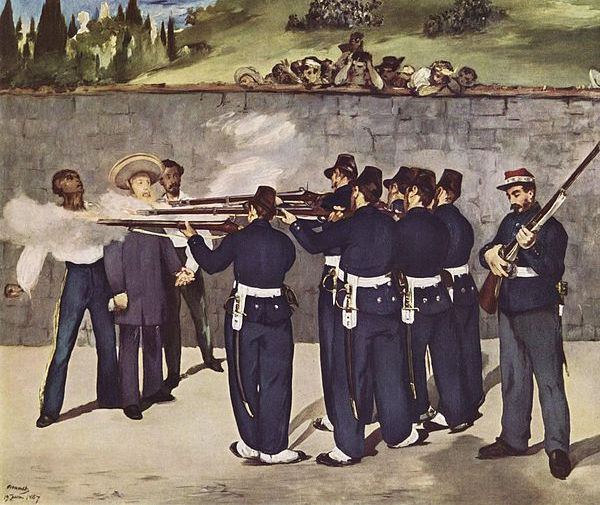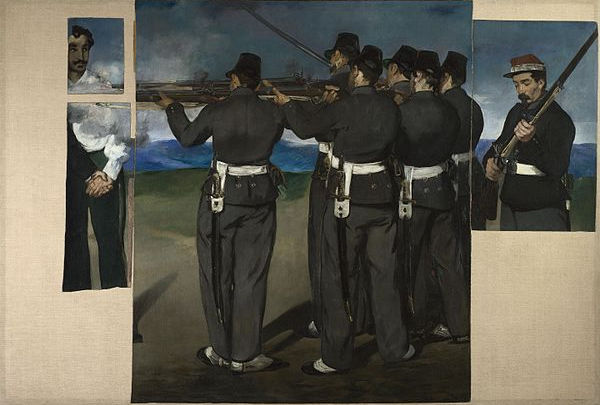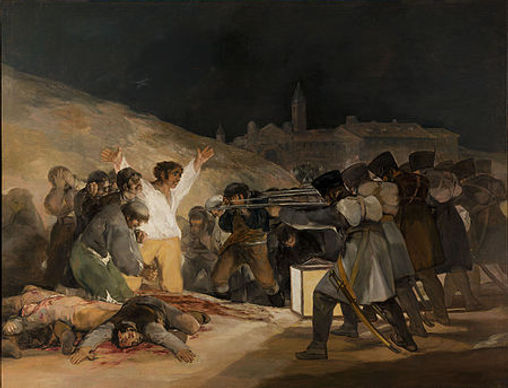<A>
Cezanne (unfinished work): *
Mont Sainte-Victoire Seen from Les Lauves. 1902-04, oil on canvas

<B>
Renoir (unfinished work): *
An example of the unfinished nature of his work is The Dance, a sketchy painting which is a sharp departure from the sombre classical work that dominated the Salon, the annual exhibition of the Académie des Beaux-Arts.
.jpg)
<C>
Manet (Shooting of. the Emperor Maximilian): *

The final work, painted in 1868–1869; the painting is signed by Manet in the lower left corner but bears the date of Maximilian's execution in 1867, despite being painted in 1868–1869.

A much smaller work in oil

A third, unfinished, oil painting

Fragments of an earlier and larger painting from about 1867–1868; Parts of that work were probably cut off by Manet, but it was largely complete on his death. Other parts were sold separately after his death.
The surviving pieces were reassembled by Edgar Degas and they were bought by the National Gallery in 1918,
then separated again until 1979, and finally combined on one canvas in 1992.
<D>
Goya (Shootings of the 3rd of May): *
On May 2, 1808, Madrid heard the news that the Spanish royal family was to be removed to France. The people of Madrid rebelled in the Dos de Mayo Uprising. Marshal Murat responded with a proclamation which demanded vengeance for the murder of Spanish troops. All rebels were to be shot. The painting is set in the early hours of the morning following the uprising] and centres on 2 masses of men: one a rigidly poised firing squad, the other a disorganized group of captives held at gunpoint. Executioners and victims face each other abruptly across a narrow space. A square lantern situated on the ground between the 2 groups throws a dramatic light on the scene. The brightest illumination falls on the huddled victims to the left, whose numbers include a monk or friar in prayer. To the right & centre of the canvas, other condemned figures stand next in line to be shot. The central figure is the brilliantly lit man kneeling amid the bloodied corpses of those already executed, his arms flung wide in either appeal or defiance. His yellow and white clothing repeats the colors of the lantern. His plain white shirt and sun-burnt face show he is a simple labourer.

<E>
Baudelaire (relationship between Wagner & Manet): *
Charles Baudelaire was a precursor to the Symbolists & was named as 1 of the 3 leading poets of the movement in the Symbolist Manifest (1886) although he had been dead for 19 years. The Symbolists were a loosely organized literary & artistic movement, origins with late 19th century French poets, influenced painting, theatre & literature. They especially valued Baudelaire’s Les Fleurs du mal (1857). They believed that art should represent absolute truths that could only be described indirectly. They wrote in a metaphorical & suggestive manner, endowing particular images with symbolic meaning. Symbolism was hostile to "plain meanings, declamations, false sentimentality and matter-of-fact description", and its goal instead was to "clothe the Ideal in a perceptible form whose goal was to depict not the thing but the effect it produces. Symbolist poems aim to evoke emotion rather than primarily describe; symbolic imagery was used to signify the state of the poet's soul.
The symbolists especially favoured Baudelaire concept of the correspondances between the senses. This correspondances or Synesthesia was a prized experience for the Symbolists. Synesthesia is a perceptual phenomenon in which stimulation of one sensory pathway leads to automatic, involuntary experiences in a second sensory pathway. In other words, colour becomes musical, music will evoke colour sensations.
[Synaesthesia is a theme which runs through Spengler. He uses the idea to suggest that oil painting was growing towards musical expression, architecture (Rococo) likewise was becoming musical in nature; Faustian music gradually adopted the trappings of colour with tone.]